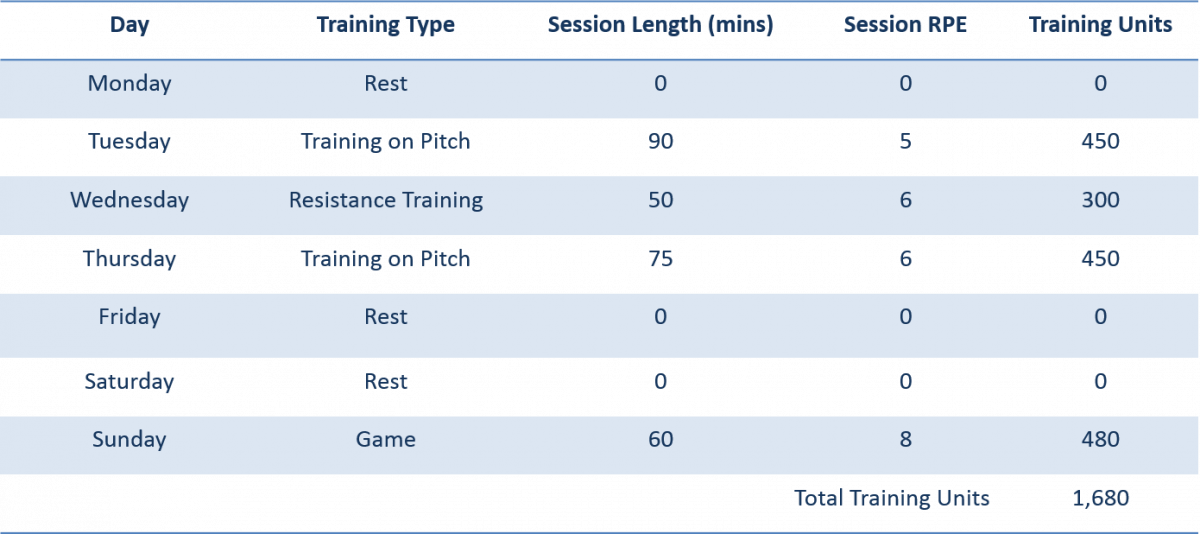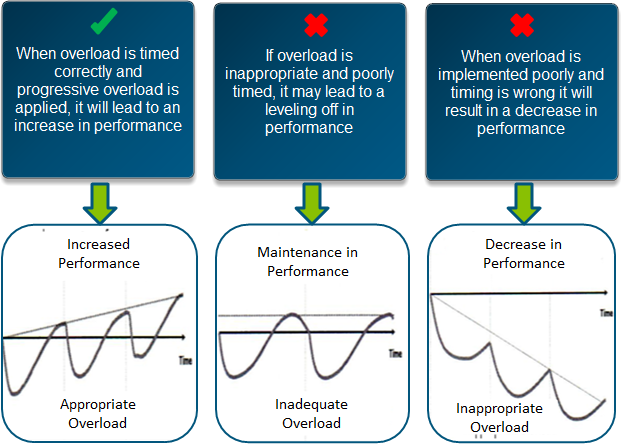 |
 |
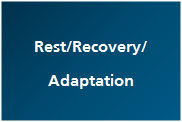 |
 |
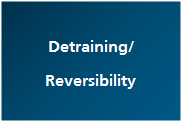 |
 |
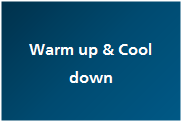 |
Overload
-
Overload is the demand placed on the body greater than which it is accustomed to at that date (Plowman & Smith, 2011)
-
Overload is probably the easiest of the principles to apply and can often be abused.
-
If overload is not applied no improvement will occur and the athlete may even regress
-
The same training session cannot be performed, session after session and expect continual improvement
-
Overload is achieved by manipulating training variables such as volume (amount of work), intensity (quality of work) and the frequency(number of training sessions)(Gambetta, 2007)
-
There is also a fine line of how much overload should be applied, as too much overload can have negative effects
-
As seen in many sports, too much overload often results in overuse injuries and burnout (Bompa, 1999)
-
The fitness level of the player/players and stage of development should be taken into account
Specificity
-
Remember the word SAID (specific adaptation to impose demands) which can be summarized as “you are what you train” (Gambetta, 2007)
-
Coaches must identify their training goal for a particular training session or group of sessions and how that session(s) fit into the overall yearly training plan
-
Coaches must then analyze the physiological requirements for meeting the training goals. What fitness attributes need to be developed? (speed, power, agility, flexibility, strength, endurance etc)
-
The closer the training program design matches the game demands the more chance of succeeding with your training program(Plowman & Smith, 2011)
-
For Gaelic Games aerobic performance can be similarly developed through small sided games if the correct intensity is prescribed when compared to long continuous running. SSGs will improve aerobic performance and skills simultaneously where continuous running will only improve aerobic capacity.
-
As an athlete gets older and competitive level gets higher the greater the level of specificity will be needed
Rest/Recovery
-
The principle of rest and recovery can often be over looked as some coaches think more is always better
-
To ensure proper recovery between sessions the best and easiest way is to ensure good sleep, sound nutrition and proper hydration
-
If an athlete is unable to recover from a training stress then the loading is inappropriate
-
Recovery has to be planned for after each overload phase
-
Ignoring this recovery phase will eventually cause fatigue and a regression in performance will occur
-
All athletes have different abilities to recover and no two athletes will recover exactly the same so this has to be taken into consideration
-
There are many other forms of recovery but these two are fundamental to proper recovery. In a later section we will cover recovery and its importance in more detail
-
It is crucial to allow sufficient recovery after periods of increased training including before and after games(Plowman & Smith, 2011)
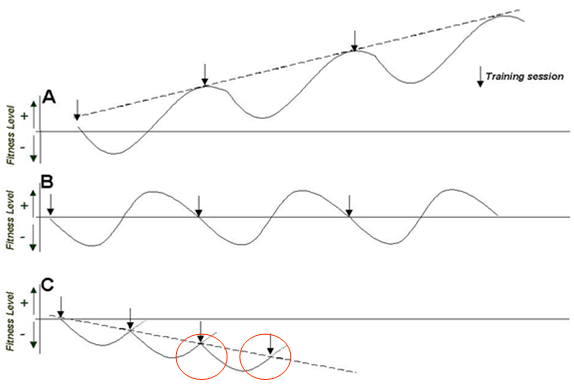
Fatigue and/or overtraining occurs when recovery interval is too short
Adaptation
-
Adaptations are physiological changes that occur in response to training overload, i.e. a training session
-
Adaptation to different training demands occurs at different rates and the ultimate training adaptation is the synergistic accumulation of a collective training responses (Gambetta, 2007)
-
Do not try and cram in too much work before a big game as this can have disastrous effects on performance
-
Performing fitness testing and keeping records to assess the amount of adaptation that occurs from a specific period of training can be very useful.
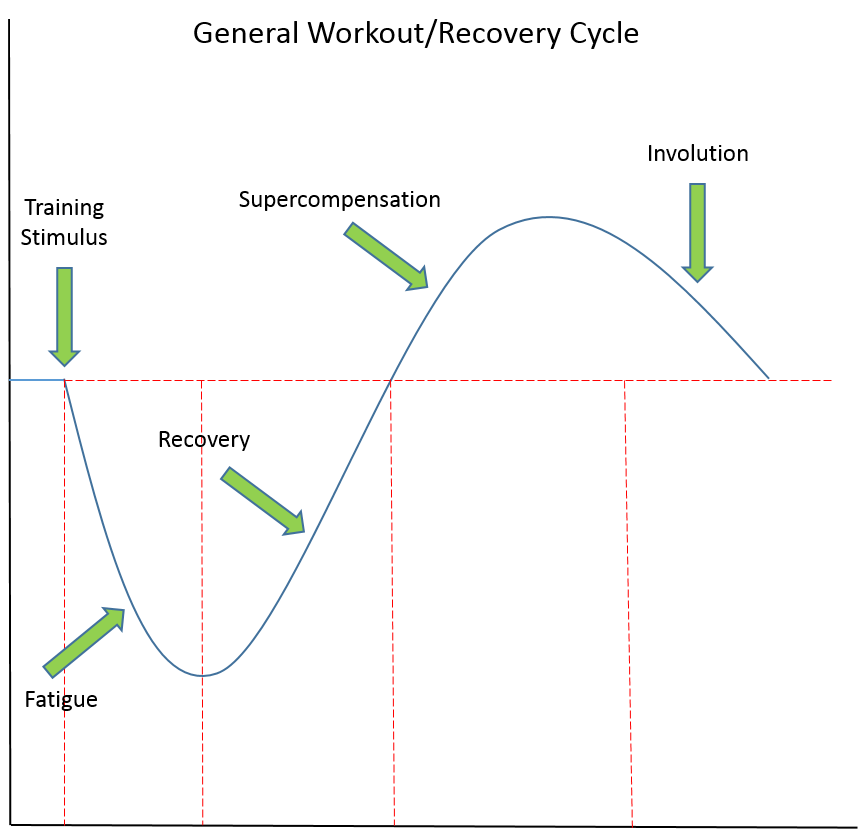
Progression
-
Progression is the change in overload in response to adaptation (Plowman & Smith, 2011).
-
This should be done in a step format increasing the training load week on week
-
Care must also be taken that a coach does not try and progress the player(s) too quickly
-
Consideration must be taken that not all training variables progress at the same rate, nor do people progress at the same rate(Gambetta, 2007)
-
Progressions need to take account of growth periods in children and incorporate increases in a safe and effective manner.
-
Coaches should plan training in a gradual manner by adjusting the volume, intensity and frequency according to the individuals need(Stratton, Reilly, Williams, & Richardson, 2004)
Detraining/Reversibility
-
Training levels must be maintained if performance levels are to be sustained
-
Progression is rarely linear, predictable or consistent but reversibility can also occur
-
When an individual's adaptation or performance levels off a plateau has been reached(Plowman & Smith, 2011).
-
Spending too much time doing the same exercises under the same conditions and in the same environment can lead to a plateau
-
Change and rest will help the player move beyond plateau
-
On the other hand if extended periods of rest are taken reversibility will occur and initial gains in fitness will be lost
-
One way to remember this is the commonly used term “If you don't use it, you lose it”
-
Detraining occurs rapidly in adults when training ceases but this may not be as apparent in youngsters because of growth(Stratton et al., 2004)
Individualisation
-
Everyone is NOT created equal from a physical standpoint
-
Players are different and will have different needs and requirements
-
A one size fits all approach is not appropriate
-
All players will adapt differently to the same training program
-
Such differences often result from lifestyle factors such as nutritional habits, sleep habits, stress levels and substance abuse. Age, sex, genetics, disease also affect individual exercise adaptations(Plowman & Smith, 2011)
-
Fitness testing and functional assessment will help identify individual needs of a playerand programs can be adjusted accordingly.
Warm Up/Cool down
-
Prepares the body for activity by elevating the body temperature while on the other hand a cool down allows gradual return to normal body temperature (Plowman & Smith, 2011)
-
Prepares the body for the activities it is about to perform in that specific training or game and try and avoid injury
-
Should consist of game specific actions such as catching, kicking and picking off ground for Gaelic football and catching, lifting and striking for hurling
-
Should gradually increase intensity with the most taxing activities happening at the end of the warm up i.e. start with jogging and finishing with a sprint
Go to GAA 15 Warm Up/Injury Prevention Programme
-
Brings the body back to pre exercise levels and to start the recovery process
-
Is only the start of the recovery process and should be followed by proper nutrition, hydration and good quality sleep.
Monitoring Training Loads
-
Keeping records of training intensity and duration can also be very useful.
-
When rate of preserved exertion (RPE) is multiplied by total session time it gives you total training units for that session, e.g. 90 minutes session x 5 (Hard Session) = 450 training units
